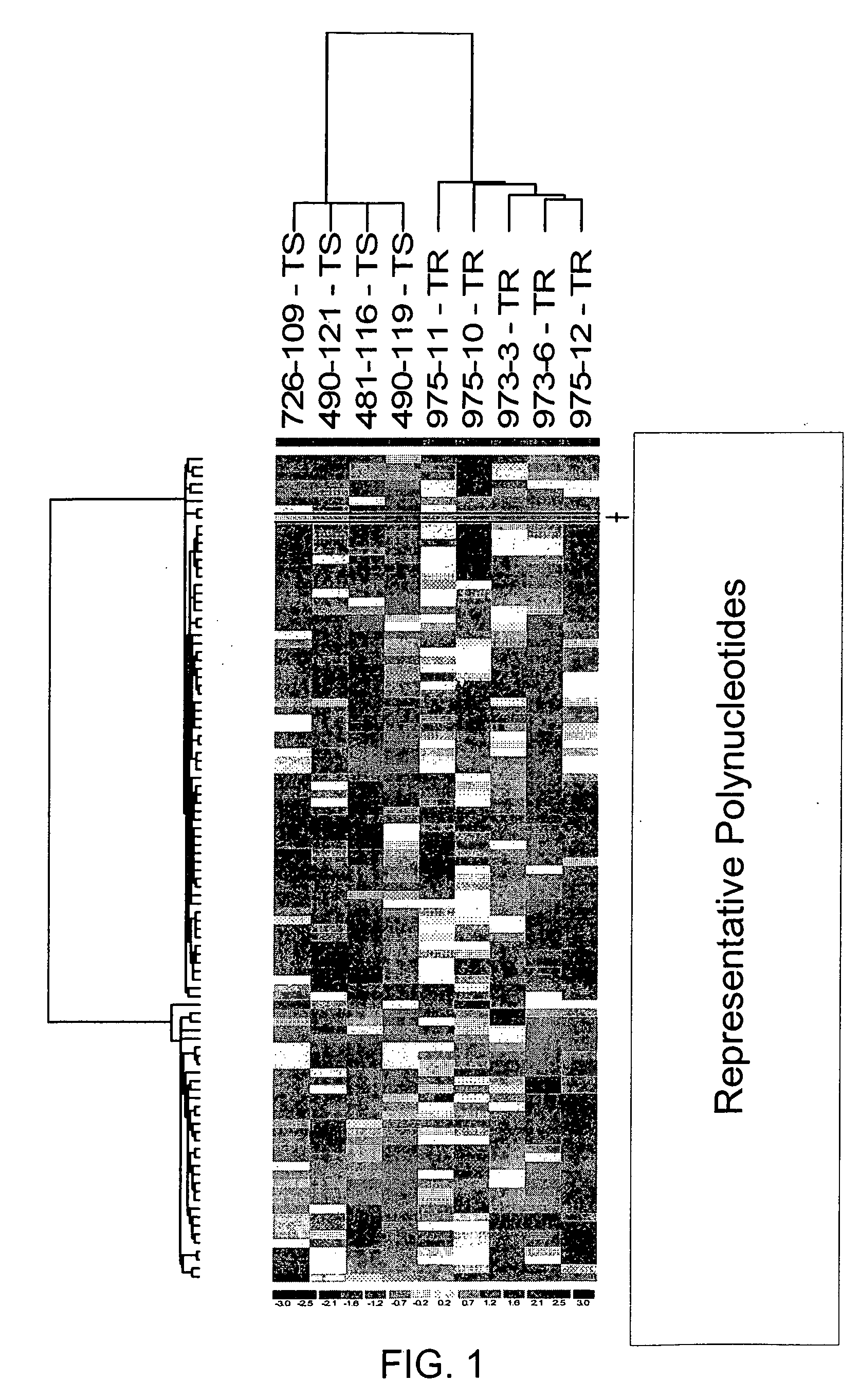RNA expression profile predicting response to tamoxifen in breast cancer patients
- Summary
- Abstract
- Description
- Claims
- Application Information
AI Technical Summary
Benefits of technology
Problems solved by technology
Method used
Image
Examples
example 1
Exemplary Materials and Methods
Reagents, Hormones, and Antibodies
[0181] 17β-Estradiol (E2) and 4-hydroxy-tamoxifen (4-OH-Tam) were from Sigma (St. Louis, Mo.). ICI 182,780 was obtained from Astrazeneca (Macclesfield, UK). The MEK1,2 inhibitor PD98065 was from Calbiochem (La Jolla, Calif.). p-nitrophenyl phosphate (PNPP) and pNPP assay buffer were obtained from Upstate Biotechnology (Charlottesville, Va.). Antibodies used for immunoblotting were to; phospho-MAPK (Thr202 / Tyr204), phospho-Ser118-ERα, and total MAPK p42 / 44 (Cell Signaling Technology, Beverly, Mass.); ERα (6F-11, Vector Labs Inc., Newcastle, UK); AIB1, p190 (BD Transduction Lab, Los Angeles, Calif.); ERK2 (C-14), PR(C-19, and H190), RhoGDI (Santa Cruz, Santa Cruz, Calif.); Cyclin D1 (Upstate Biotechnology); V5 (InVitrogen, Carlsbad, Calif.); HA (Covance, Berkeley, Calif.).
Tumor Specimens, Expression Microarray Analysis, and Semiquantitative RT-PCR
[0182] A cohort of frozen breast tumor specimens from nine patients w...
example 2
MKP3 Overexpression and TR
[0192] To identify genes whose expression is associated with the development of TR, compared primary tumors with metastatic tumors that arose during adjuvant Tam treatment using expression microarray and sqRT-PCR analyses. The approach and tumor selection criteria differed from that recently reported by Ma et al. (2004), who compared primary tumors of patients that were disease-free after adjuvant Tam treatment to primary tumors of patients that recurred with a median time to recurrence of 4 years to generate a gene expression profile to predict clinical outcome (Ma et al., 2003). In specific embodiments, it is more likely to identify genes whose differential expression reflected acquired TR with this selection criteria, and whose function might itself be affected by Tam treatment.
[0193] Gene expression analysis of the cohort identified MKP3 as being more highly expressed in the Tam-resistant tumor group as compared to the Tam-sensitive tumor group (p<0.0...
example 3
DUSP6 (MKP3) as a Coactivator of Estrogen Receptor
[0204] There are a large number of estrogen receptor (ER) coregulatory proteins that function as signaling intermediates between the ERs and the general transcriptional machinery (for reviews, see McKenna et al. 1999, and Horwitz et al. 1996). These coregulatory proteins are components of a complex of proteins bound to the nuclear receptors, and their presence or absence can help determine if the receptors act as a transcriptional repressor or activator. Some of the coregulatory proteins, called coactivators, possess enzymatic activity, but the precise mechanism by which coactivators enhance ER transactivation function remains to be determined. The receptor interacting motif LXXLL (called the ‘NR’ box; SEQ ID NO:167) has been identified within nearly all coactivators, and these residues are indispensable for receptor interaction with coactivators (Heery et al. 1997). It may be a relative imbalance of coregulator proteins that ultima...
PUM
| Property | Measurement | Unit |
|---|---|---|
| Time | aaaaa | aaaaa |
| Time | aaaaa | aaaaa |
| Fraction | aaaaa | aaaaa |
Abstract
Description
Claims
Application Information
 Login to View More
Login to View More - R&D
- Intellectual Property
- Life Sciences
- Materials
- Tech Scout
- Unparalleled Data Quality
- Higher Quality Content
- 60% Fewer Hallucinations
Browse by: Latest US Patents, China's latest patents, Technical Efficacy Thesaurus, Application Domain, Technology Topic, Popular Technical Reports.
© 2025 PatSnap. All rights reserved.Legal|Privacy policy|Modern Slavery Act Transparency Statement|Sitemap|About US| Contact US: help@patsnap.com



